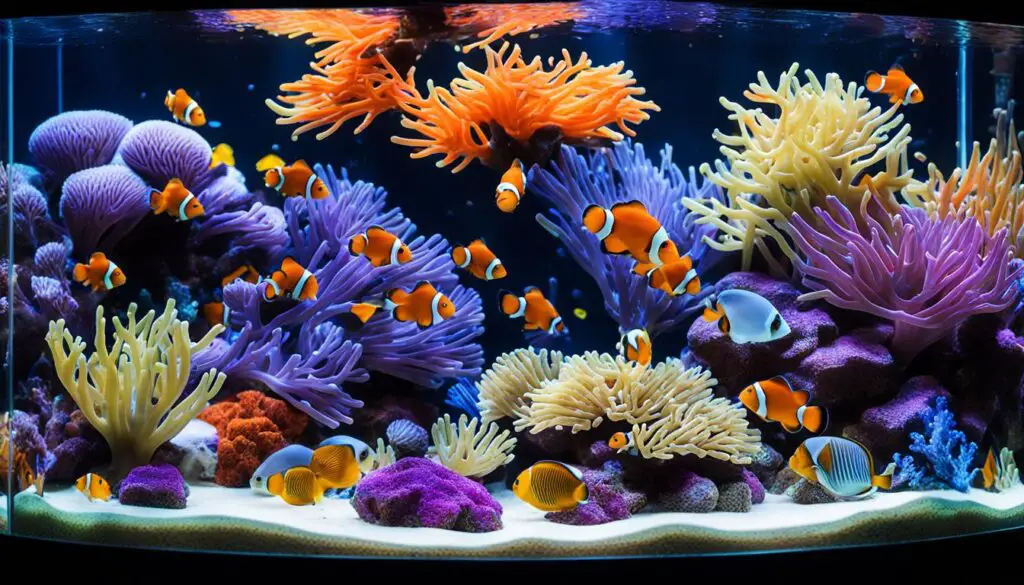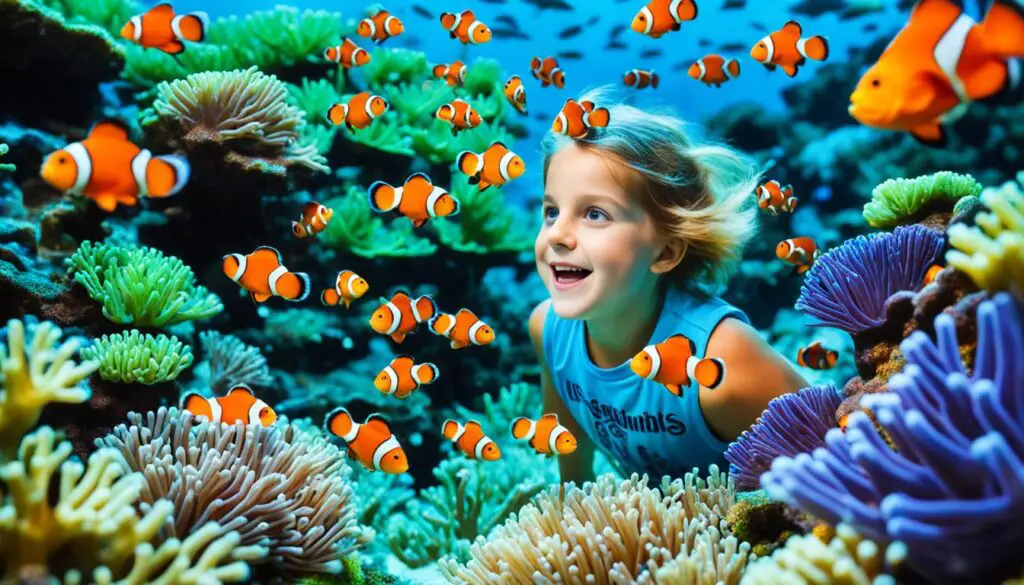Coral Reef Diversity: Dive into Diversity: Exploring the Colorful Coral Reef Ecosystem!
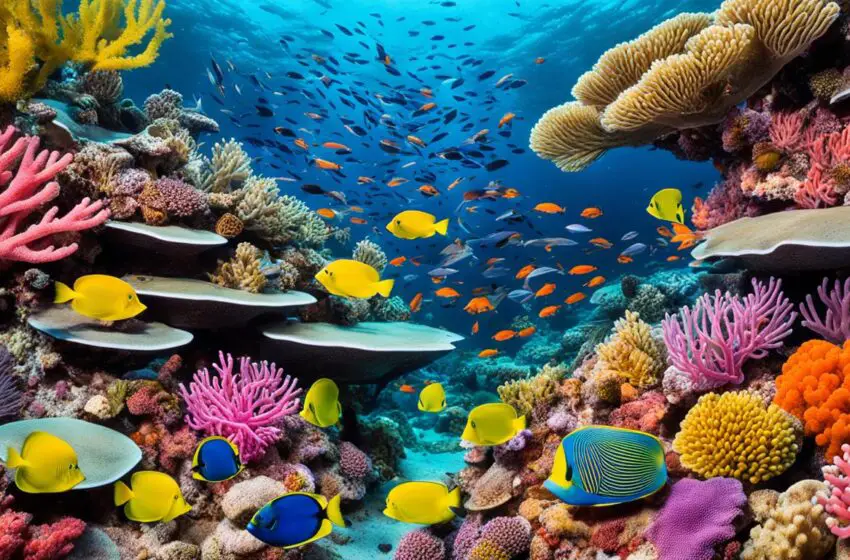
Coral reefs are stunning and diverse, making up a breathtaking underwater world. They are formed by groups of coral polyps and are found in warm, shallow seas. These beautiful structures are not just pretty to look at. They’re also essential for the health of many marine animals.
Despite covering less than one percent of the ocean, coral reefs support a quarter of all marine life. They are like a safe space for many sea creatures to grow up and survive. These ecosystems also provide food for big animals like sea turtles and sharks.
Yet, coral reefs are in trouble. They face threats from the warming climate, ocean acidification, overfishing, and pollution. These dangers put the life in the reefs at risk. We need to protect them to help save our oceans’ diverse wildlife.
Key Takeaways:
- Coral reefs are one of the most diverse ecosystems on the planet, housing a quarter of all marine life.
- They provide shelter, food, and reproduction sites for countless reef organisms.
- Coral reefs act as nurseries for marine species and feeding grounds for larger organisms like sea turtles, sharks, and whales.
- These vibrant ecosystems are under threat from human activities, climate change, and pollution.
- Protecting coral reefs is essential for maintaining marine biodiversity and the health of our oceans.
The Beauty of Coral Reefs
Coral reefs are stunning underwater worlds. They’re full of vibrant colors and complex designs. These ecosystems show us the amazing beauty below the ocean’s surface.
Their colors come from a special relationship. Coral polyps and algae live together. The algae help the coral make food using sunlight. This process also creates the bright colors we see in reefs, from blues to pinks.
The shapes and patterns of corals are also amazing. Some look like sea trees, while others are like mazes. Their designs capture the hearts of all who see them.
But, coral reefs are more than just beautiful. They support locals through tourism and fun water activities. Many people visit to see the unique artwork of each reef.
Yet, reefs are in danger because of people. Overfishing, pollution, and climate change hurt them. We must act to keep these beautiful places thriving for the next generation.
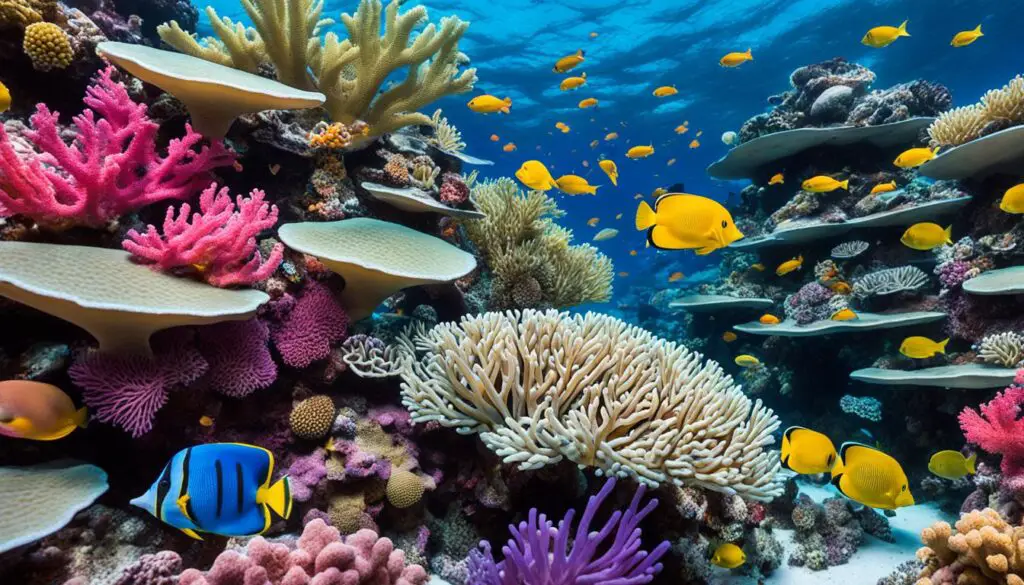
Quotes:
“The vibrant colors and intricate patterns of coral reefs are a testament to the unparalleled beauty found in nature’s hidden treasures.” – Marine Biologist
“Coral reefs are like underwater masterpieces, painted with nature’s brushstrokes. Their exquisite beauty is a glimpse into the magnificence of the underwater world.” – Oceanographer
Coral Reef Colors
| Coral Colors | Description |
|---|---|
| Blue | Reflects a sense of tranquility and depth |
| Green | Symbolizes vitality and growth |
| Pink | Emanates a delicate and feminine charm |
| Purple | Evokes a sense of mystery and royalty |
| Yellow | Represents warmth and sunshine |
| Red | Signifies passion and strength |
The Role of Coral Reefs in Marine Biodiversity
Coral reefs are key in marine biodiversity, helping many marine species thrive. They are home to a variety of fish, crustaceans, and mollusks. These creatures find shelter, breed, and feed in the complex structures of coral reefs.
But coral reefs are not just for the smaller sea life. They are crucial feeding and living spots for larger animals like sea turtles, sharks, and whales. These amazing creatures need the rich life of the coral reefs to survive.
Beyond marine life, coral reefs help keep our oceans healthy. They balance seawater chemistry by absorbing carbon dioxide and giving off oxygen. This process aids in the balancing act of the marine environment.
“Coral reefs are essential for maintaining the biodiversity of marine ecosystems, providing a home for countless species and contributing to the overall health of our oceans.”
Corals also have a big role in our lives. They are cultural, recreational, and economic assets. Tourism and fishing linked to coral reefs support millions of people worldwide. This makes them crucial for both local economies and global food supply.
Protecting coral reefs is vital for their biodiversity and economic benefits. We need to use sustainable methods, decrease pollution, and fight climate change. These actions will help keep coral reefs healthy for our children.
Threats to Coral Reefs
| Threat | Description |
|---|---|
| Climate Change | Rising sea temperatures and ocean acidification contribute to coral bleaching and eventual death. |
| Overfishing | Excessive fishing can disrupt food chains and lead to imbalances within coral reef ecosystems. |
| Pollution | Contaminants from urban runoff, agricultural activities, and improper waste management negatively impact coral reefs. |
| Destructive Practices | Physical damage caused by activities such as dynamite fishing and anchor damage can destroy coral reefs. |
Protecting coral reefs is not only an environmental imperative but also crucial for sustaining the remarkable diversity of marine life and the communities that depend on them.
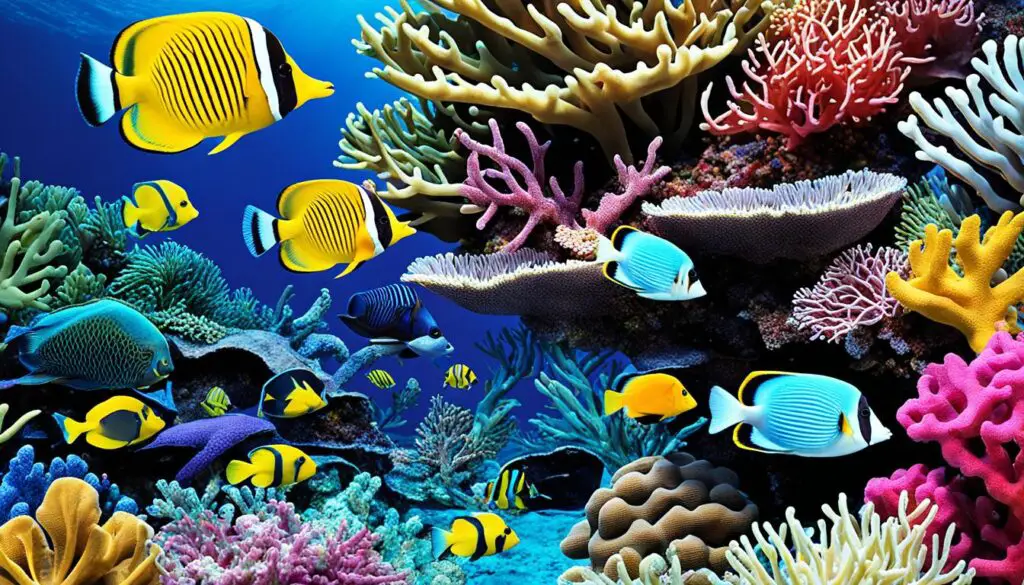
In the next section, we will explore the impact of human activities and climate change on coral reefs, uncovering the challenges faced by these fragile ecosystems.
The Impact of Human Activities and Climate Change on Coral Reefs
Coral reefs are under huge threats from people and climate change. Overfishing, pollution, and bad fishing harm them a lot. These actions throw off the reef’s balance. The water’s temperature and acidity are also changing due to climate change. This leads to coral bleaching. When corals bleach, they lose their color and risk dying. This hurts the whole reef.
Human activities like building and tourism also hurt coral reefs. They bring more nutrients, dirt, and physical damage. All these things make it tougher for coral reefs to survive.
To help coral reefs, we need to do a few things. First, we must cut down on things that cause climate change. This will lessen the problems that affect coral reefs. We also need to fish in ways that don’t harm the reefs. Finally, we should lower pollution. This means less runoff and dirt, which will keep our coral reefs beautiful and full of life for the future.
FAQ
What are coral reefs?
Coral reefs are underwater homes made of tiny creatures called coral polyps. They provide a place to live, food, and a space to have babies for many sea animals.
Why are coral reefs important?
They are rich in life, helping 25 percent of the ocean’s creatures, yet they only cover about one percent of the sea. Coral reefs are essential as baby areas of the sea, food for bigger animals, and they shield shores from rough weather and damage.
What threatens coral reefs?
Many things hurt coral reefs. This includes warmer seas, acid from the ocean, too much fishing, and pollution.
What do coral reefs look like?
Coral reefs are beautiful and full of color and shape. They can be as small as branches or as big as rocks.
How do coral reefs support marine biodiversity?
These reefs are homes and food for a lot of marine life. They even help balance the ocean’s chemistry, turning bad carbon dioxide into good oxygen through photosynthesis.
What are the impacts of human activities and climate change on coral reefs?
Humans doing too much fishing, polluting, and bad fishing hurt reefs a lot. Climate change can make corals lose their color too. Development and tourism add to these problems, leading to bad water, sinking dirt, and direct harm to coral homes.
How can we protect coral reefs?
We can help by slowing down climate change, fishing smarter, and making less pollution. It’s up to us to safeguard these special living places for tomorrow.


